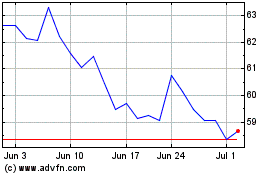Budweiser, Bud Light Volumes Fall Sharply in U.S. but AB InBev Squeezes Costs -- Update
May 09 2018 - 6:41AM
Dow Jones News
By Nick Kostov
Big brewers are losing their grip on America's beer belly.
Anheuser-Busch InBev SA, which makes Budweiser, Bud Light and
Stella Artois, said Wednesday overall sales volume in North America
fell 4.1% over the first three months of the year from a year
earlier, due largely to declines in Bud Light and Budweiser. Molson
Coors Brewing Co. said last week that it also struggled, losing
3.8% in brand volume in the U.S., while beer volume at Heineken
NV's U.S. unit declined by a high single-digit percentage in the
first quarter.
The U.S. has been turning away from big beer for years, but
brewers say demand was even more anemic than expected in the first
quarter.
Sales to wholesalers in the U.S. at AB InBev were down 4.4%,
with revenue decreasing 2.5% in the first quarter. The brewer
estimated that sales to retailers declined 2.3% across the industry
in the first quarter.
The silver lining for AB InBev in North America is that its
revenue per hectoliter grew 1.9% over the period as management kept
a tight lid on costs and consumers paid more for their brews.
Shares rose 3% in morning trading in Europe.
"While we acknowledge we still have work to do in the U.S., we
are moving in the right direction," Chief Financial Officer Felipe
Dutra told reporters.
Michelob Ultra -- marketed as the beer for people with an active
lifestyle -- continued to perform well, AB InBev said, as did
Stella Artois, which continued to gain share in the so-called
"above premium category." The company said its portfolio of beers
it markets as craft beer also performed well.
But the brewer's Budweiser and Bud Light brands continued to
lose market share in the U.S. Overall, the company estimated it
lost half a percentage point of market share in the quarter.
Speaking on a call with reporters, Mr. Dutra said AB InBev had
lost market share because a large part of its business is in
declining categories, rather than growing segments of the market
like craft beer. Executives at the company have been trying to
boost profits and margins by persuading consumers to buy more
expensive beers. The company recently rolled out Michelob Ultra
Pure Gold, made with organic grains, as well as Bud Light Orange
and a "refreshed" Bud Light Lime, which are both brewed with real
citrus peels.
Globally, AB InBev said earnings before interest, taxes,
depreciation and amortization -- a key measure watched by analysts
-- rose 6.6% to $4.99 billion in the first quarter, topping analyst
expectations of a 4.7% rise.
In the U.S., a rise in the price of hedging aluminum and
increased freight costs led to margin contraction and a 5% decline
in Ebitda, although Mr. Dutra said that "underlying beer trends
remain unchanged."
The Leuven, Belgium-based brewer said beer volumes grew strongly
in Mexico, Colombia and Argentina, but declined in Brazil, its
second-largest market, as well as the U.S. The brewer had flagged
that the first quarter was likely to be weak, in part because of an
early end to Carnival season in the Latin American country and
increased sales and marketing spending tied to the coming soccer
World Cup in Russia.
Revenue increased to $13.07 billion from $12.92 billion. Net
profit decreased to $1.02 billion from $1.40 billion.
Mr. Dutra said that the first quarter "was better than we
initially expected" and that growth should accelerate through the
rest of the year, particularly in the second half.
The company said it found another $160 million of cost savings
tied to its almost $100 billion acquisition of SABMiller, bringing
the total to $2.29 billion since it completed the deal in October
2016.
Write to Nick Kostov at Nick.Kostov@wsj.com
(END) Dow Jones Newswires
May 09, 2018 06:26 ET (10:26 GMT)
Copyright (c) 2018 Dow Jones & Company, Inc.
Anheuser Busch Inbev SA NV (NYSE:BUD)
Historical Stock Chart
From Mar 2024 to Apr 2024

Anheuser Busch Inbev SA NV (NYSE:BUD)
Historical Stock Chart
From Apr 2023 to Apr 2024
